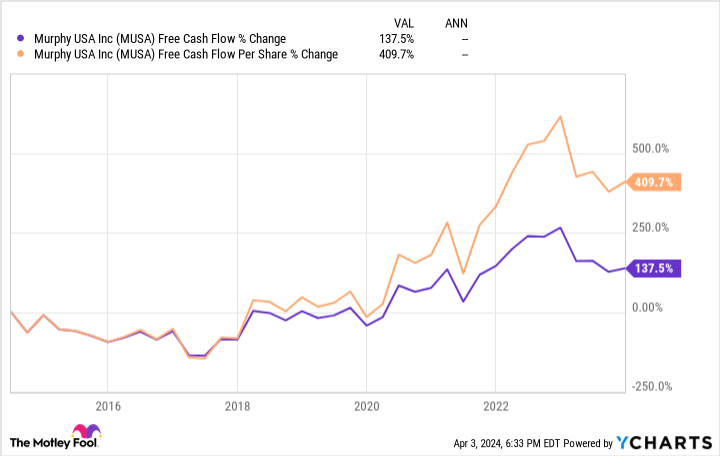Convenience-store chain Murphy USA (MUSA 1.22%) has delivered a total return of 1,000% since its 2013 spinoff from Murphy Oil, more than tripling the returns provided by the S&P 500 index. Murphy USA's insatiable appetite for its shares has aided these staggering returns. Buying back more than 55% of its outstanding shares over this time has made the company an unlikely multibagger for buy-and-hold investors.
But it's much more than a share-repurchasing, one-trick pony. Here's what sets the company up for enduring success over the coming decades.

Image Source: Getty Images.
Murphy USA's low-price focus amplifies its growth story
With 1,733 stores primarily across the southern and southeastern United States, Murphy USA serves more than 2 million customers daily. Most of its locations are next to Walmart stores, thanks to a past partnership with the retailer, and Murphy steadily grew to become the fourth-largest convenience store chain in the U.S.
The company is no longer exclusive in its relationship with Walmart, but the two have an ongoing collaboration that sees Walmart+ members receive discounts up to 10 cents per gallon at Murphy locations. So it's probably no surprise that Murphy is also a proponent of the "everyday low price" business model.
It had an average fuel price $0.12 lower per gallon than its peers in 2023, giving it a value proposition that its smaller-scale competitors cannot match. Single-store operators make up 60% of the highly fragmented convenience store industry in the U.S., so large-scale chains like Murphy are in a good position to continue vacuuming up market share within the niche.
Management estimates that 63% of U.S. consumers live paycheck to paycheck. These tight budgets make the company's value proposition attractive and help explain how the Murphy Drive Rewards loyalty program quickly grew to 8 million members after launching in 2019.
The company plans to increase its store count by 45 to 50 (or 3%) annually through 2028, taking this low-price business model to new markets. There are ample geographic greenfield opportunities ahead of it -- paired with the majority of convenience stores being unable to compete with the company's pricing. So Murphy could see decades of steady growth ahead.
The power of share repurchases
Best of all for investors, Murphy's fuel margin has been above $0.30 per gallon for the last two years despite the company's focus on low pricing. It sells nearly 5 billion gallons of fuel annually, so its fuel margin and merchandise sales per square foot that are in the top 25% combine to create a cash-generating powerhouse.
MUSA cash from operations (TTM) data by YCharts; TTM = trailing 12 months.
This cash creation easily funds the company's growth ambitions in-house. Plenty of free cash flow (FCF) is left over after its capital expenditures, so management consistently rewards shareholders with stock buybacks.
The share count has been lowered 7% annually since 2013, and management has effectively eliminated 55% of Murphy's outstanding shares since being spun off. The following chart highlights the power of these buybacks.
MUSA free cash flow data by YCharts.
While FCF grew by 138% over the last decade, the company's FCF per share ballooned fivefold thanks to a lower share count. Murphy's scale, its expansion plans, and the growing cash flows leave the company primed to continue reducing its share count far into the future.
Should investors buy shares, too?
Total returns are north of 1,000% since 2013, and Murphy's incredible past performance -- and remaining potential -- have caught the market's attention.
MUSA PE ratio data by YCharts; EV = enterprise value. EBITDA = earnings before interest, taxes, depreciation, and amortization.
The company trades at a hefty premium to its 10-year averages by virtually any valuation metric. But while its price-to-earnings (P/E) ratio of 16 is above its own historical averages, it remains well below the S&P 500's average of 23.
This below-market valuation -- despite nearing its own all-time highs -- means dollar-cost averaging might be the best choice for investors. By building a position in increments over time, this approach lets investors get skin in the game at various price points rather than going all-in at one price.
Murphy USA operates in a convenience-store industry that can't effectively match the company's pricing, so its multibagging ways look poised to persist as it continues expanding geographically, buying back shares as it goes.








